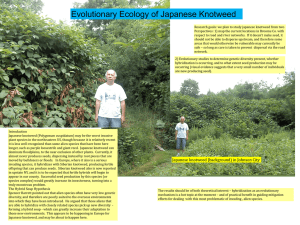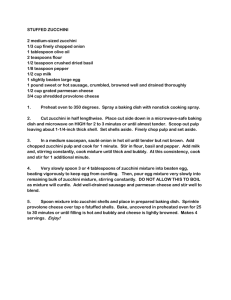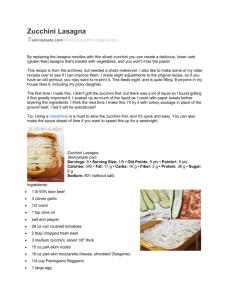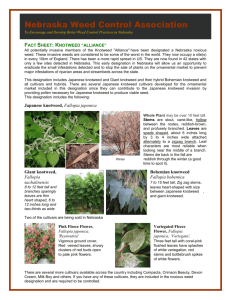Effect of EM Fermented Plant Extracts on Zucchini
advertisement
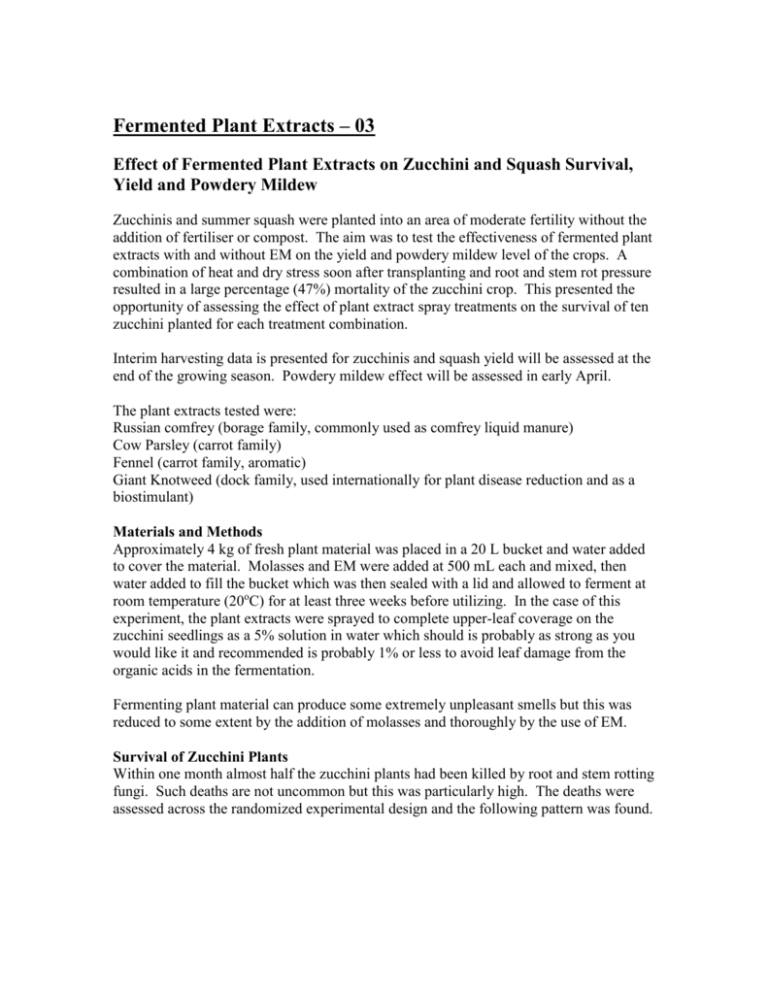
Fermented Plant Extracts – 03 Effect of Fermented Plant Extracts on Zucchini and Squash Survival, Yield and Powdery Mildew Zucchinis and summer squash were planted into an area of moderate fertility without the addition of fertiliser or compost. The aim was to test the effectiveness of fermented plant extracts with and without EM on the yield and powdery mildew level of the crops. A combination of heat and dry stress soon after transplanting and root and stem rot pressure resulted in a large percentage (47%) mortality of the zucchini crop. This presented the opportunity of assessing the effect of plant extract spray treatments on the survival of ten zucchini planted for each treatment combination. Interim harvesting data is presented for zucchinis and squash yield will be assessed at the end of the growing season. Powdery mildew effect will be assessed in early April. The plant extracts tested were: Russian comfrey (borage family, commonly used as comfrey liquid manure) Cow Parsley (carrot family) Fennel (carrot family, aromatic) Giant Knotweed (dock family, used internationally for plant disease reduction and as a biostimulant) Materials and Methods Approximately 4 kg of fresh plant material was placed in a 20 L bucket and water added to cover the material. Molasses and EM were added at 500 mL each and mixed, then water added to fill the bucket which was then sealed with a lid and allowed to ferment at room temperature (20oC) for at least three weeks before utilizing. In the case of this experiment, the plant extracts were sprayed to complete upper-leaf coverage on the zucchini seedlings as a 5% solution in water which should is probably as strong as you would like it and recommended is probably 1% or less to avoid leaf damage from the organic acids in the fermentation. Fermenting plant material can produce some extremely unpleasant smells but this was reduced to some extent by the addition of molasses and thoroughly by the use of EM. Survival of Zucchini Plants Within one month almost half the zucchini plants had been killed by root and stem rotting fungi. Such deaths are not uncommon but this was particularly high. The deaths were assessed across the randomized experimental design and the following pattern was found. Table 1. Percentage survival of zucchini plants according to treatments Plant Extract Fennel Comfrey Cow Parsley Giant Knotweed Average Water 50 40 30 60 45 Fermentation Ingredients Molasses EM + Molasses 10 60 40 70 40 70 70 100 40 Average 40 50 47 77 75 Note: Plants sprayed with an equivalent amount of water alone (control) or not sprayed at all (nil control) had a percentage survival of 40 and 30% respectively. An analysis (twoway ANOVA) of the combined results showed that there was a statistically significant effect on plant survival due to both fermentation ingredient (p=0.039) and a plant extract type (p=0.013). The EM fermentation of all plant extracts was shown to significantly increase the survival of zucchini plants almost by a factor of two (statistically significant p<0.05). Of the plant extracts, only one showed significant improvement over the others and controls, this being giant knotweed, already known internationally for biostimulant use and disease reduction in crops (statistically significant p<0.05). Most notably, there was 100% survival when the treatment was EM fermented giant knotweed. Zucchini Yield Interim results show that both EM fermentation and giant knotweed treatments tended to increase zucchini yield per plant (in kg) but as at mid March, this was not statistically significant (onetailed t-test, extra 23.0% p=0.13 and 19.0% p=0.20 for EM and knotweed treatments respectively). Due to the difference in number of surviving plants, the total yield per treatment due to these treatments was statistically significant (extra 109% p<0.01 and 103% p=0.04 for EM and knotweed respectively). Discussion To date, both the use of giant knotweed and the fermentation with EM have resulted in higher plant survival and a tendency towards higher yield per plant. Results will be available soon on final yield and powdery mildew levels. Further experimentation is planned with fermented plant extracts, knotweed and EM to determine the extent of their effects on a range of crops and diseases.

